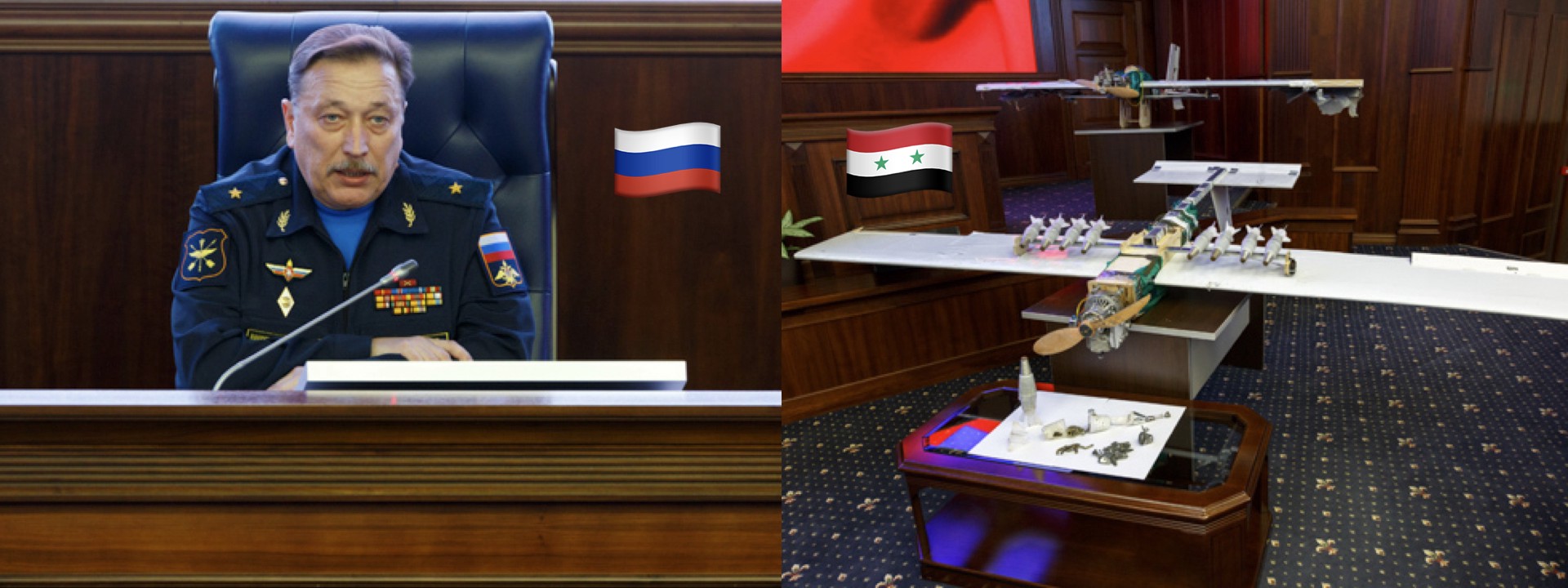#PutinAtWar: Drone Attack at Khmeimim
Investigating Russian MoD official statements about the January 5 drone attack in Khmeimim
#PutinAtWar: Drone Attack at Khmeimim

Investigating Russian MoD official statements about the January 5 drone attack in Khmeimim

During the night of January 5, Khmeimim base and the Tartus naval facility were reportedly attacked by militants with 13 improvised and homemade drones. The Russian Ministry of Defense (MoD) reported forces successfully repelled the attack and provided images of the downed drones. On January 11, the MoD provided an official briefing on the drone attack.
The Attack
On January 8, Russian MoD official Facebook page reported an attack that targeted Russian military facilities in Syria, specifically ten drones at Khmeimim and three drones at Tartus. According to the post, six drones were intercepted by the Russian electronic warfare units, while seven drones were eliminated by the Pantsir-S (NATO reporting name SA-22 Greyhound) anti-aircraft missile complexes. Russian MoD reported no casualties or equipment damage.
https://www.facebook.com/mod.mil.rus/posts/2031218563787556
The Briefing
On January 11, the head of the Russian General Staff’s Office for Unmanned Aerial Vehicle (UAV) Development, Major General Alexander Novikov, provided an update during an official briefing.
Novikov focused heavily on the drones’ on-board global positioning system (GPS), which he alleged evidenced potential help from the other countries, namely United States. The Major General insisted that these parts enabled the drones military-grade precision when navigating to Khmeimim and released their bombs over the target area. The briefing included maps of the pre-programmed flight routes, which the MoD claimed to have downloaded from the captured drones. Novikov did not provide any concrete evidence to support his claims.

Here are the locations pin-pointed on the map.
Novikov also declared that militants alone would not have been able to conduct the necessary research and development without significant assistance. This statement was questionable, since all of the parts are available for purchase online, not to mention that operational devices can be bought online.

The Subtle Accusations
Even though the militant groups responsible for the attack were not yet identified, Russian MoD accusations were prevalent in the official Russian MoD statement. The January 8 post had subtle messaging, potentially accusing United States of aiding the militants.
Engineering decisions applied by terrorists while attacks on the Russian objects in Syria could be received from one of countries with high-technological capabilities of satellite navigation and remote dropping control of professionally assembled improvised explosive devices in assigned coordinates.
These accusations were denied by the Pentagon and investigated by the Daily Beast, a U.S. media outlet. The Daily Beast demonstrated improvised and homemade drones were available for sale in a rebel social media arms market based in Syria’s Idlib province.
After the Pentagon denied accusations of aid, the next brief from the Russian MoD on January 11 alleged new nefarious sources of aid behind the foiled attack. During the briefing, the purported help from the United States was not mentioned, but Ukraine emerged as a potential supplier of drone parts to Syrian rebels. Specifically, Major General Alexander Novikov suggested the source of the explosive material inside the bombs might be coming from Ukraine.
The PETN (pentaerythritol tetranitrate) is produced by a number of countries, including Ukraine at the Shostkinsky Chemical Plant. This explosive material cannot be produced in an improvised manner or extracted from other munitions.

Other than Syria and Russia, Ukraine was the only other country mentioned in the briefing. Novikov failed to mention the fact that PETN was a favorite explosive of terrorists in many attacks and attempts throughout the recent years in Syria.
A recent report by the Wall Street Journal (WSJ) provided futher details with regard to the Khmeimim airbase attacks on December 31 and January 5. The WSJ article argued that the militants used drones during both attacks, which revealed Russian military’s lack of preparedness. According to an undisclosed WSJ source, Novikov’s briefings have largely served to deflect attention away from the exposure and vulnerability of the Khmeimim airbase.
Conclusions
The reaction of the Russian MoD to the January 5 drone attack differs significantly from the reaction to the December 31 attack, which was largely reported on as a mortar attack. Repelling the January 5 drone attack was described as a military success story by the Russian MoD. Reportedly, all of the 13 drones were overtaken or destroyed by the Russian force, therefore the story was presented publicly and amplified, with narratives highlighting opponents like the United States and Ukraine subtly woven in.
@DFRLab will continue monitoring Russia’s military actions and developments in Syria.
Follow along for more in-depth analysis from our #DigitalSherlocks.

